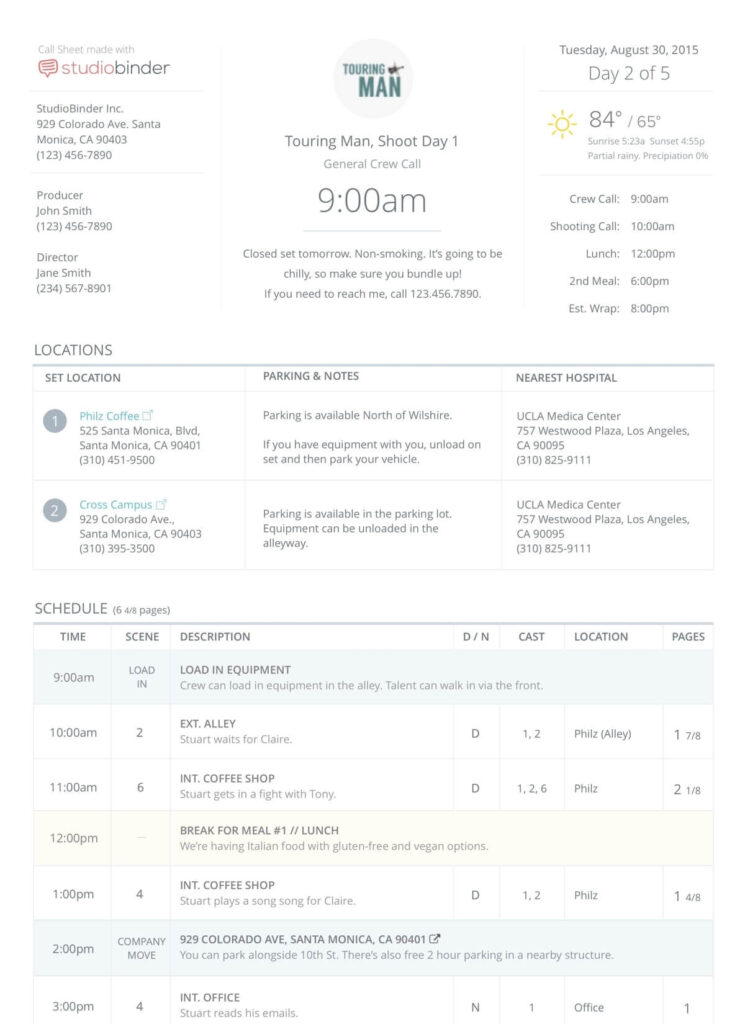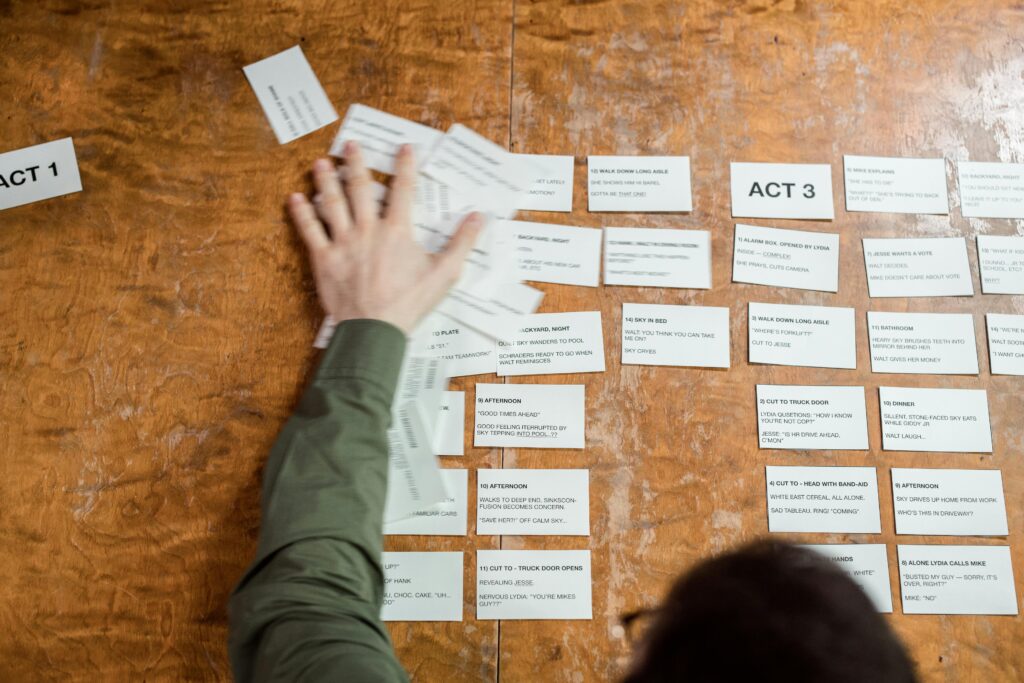

When it comes to making a film a reality, your call sheet is the lifeline that keeps the production running smoothly, bridging the gap between pre-production and getting your hands dirty during filming. Call sheets ensure that everyone is on the same page, meaning that you can minimise delays and maximise efficiency to bring your vision to life on screen.
In this article, we will explore the importance of a film call sheet and provide you with practical tips on how to create one effectively.
Contents:
A call sheet plays a crucial role in the smooth running of a film production, serving as the backbone of crew coordination. Typically, a call sheet will contain vital information such as the shooting schedule, location details, contact information, and specific requirements for the day. It provides clarity and ensures that everyone involved is well-prepared and knows exactly what is expected of them.

This central document acts as a reference point for everyone involved on the day of the shoot. Crucially, call times dictate when each person is expected to arrive on set, which ensures that everyone arrives promptly and is ready to start shooting at the designated time. The call sheet also outlines the schedule for the day, including scene numbers, shot descriptions, and any special requirements.
A successful call sheet should provide all the necessary information for a smooth production day. It should include the following key components:
Aside from these essential components, a well-crafted call sheet also takes into account the individual needs and preferences of the cast and crew members. For example, it may include dietary restrictions or allergies to ensure that meals provided on set cater to everyone's needs.
It may also include information about nearby amenities such as restrooms, parking facilities, and nearby cafes or restaurants for convenience during breaks. You should always include the local emergency contact number, especially if working in a foreign country.
A well-mapped call sheet goes beyond just providing logistical information. It can also serve as a platform for creative collaboration and inspiration. For instance, it may include references to visual inspiration, such as photographs or mood boards, to help the team visualise the desired aesthetic or tone for the shoot. This can foster a shared understanding and vision among the cast and crew, enhancing the overall creative process.
SuperScout is your own private location library – upload locations in minutes, tag them with ai in seconds, then search and share with your team

Formatting plays a crucial role in making your call sheet easy to read and understand. Use a clear and legible font, ensuring that the text is large enough to be read comfortably. Break up the information into sections with subheadings, making it easier for readers to navigate through the document. Consider using bullet points or numbered lists to organise the information, making it visually appealing and easy to scan.
Incorporating branding elements such as the production company's logo or colour scheme can add a professional touch to the call sheet. Consistency in design not only enhances the document's aesthetic appeal but also reinforces the production's identity. Remember, a well-organised and visually appealing call sheet reflects positively on the professionalism of the production team.

Clear and concise communication is paramount when it comes to a call sheet. When it comes to making a film, every detail matters. It is crucial to use language that is easily understood by all members of the production team, regardless of their role or experience level. Avoiding technical jargon or industry-specific terms that may confuse or mislead anyone is essential. Double-checking all the information to ensure accuracy is a non-negotiable step. A seemingly minor mistake in the call sheet can lead to significant disruptions on set, potentially costing time and money. Therefore, meticulous attention to detail is imperative before distributing the document.
Incorporating a section in the call sheet for emergency contacts can be a lifesaver in unforeseen circumstances. Providing quick access to essential contact information, such as medical services, security personnel, or key production team members, can help mitigate risks and ensure a swift response to any emergencies that may arise during the shoot.
Digital call sheet tools offer numerous advantages over traditional paper-based call sheets. They allow for easy collaboration and real-time updates, ensuring that everyone has access to the most up-to-date information. Digital call sheets can also incorporate additional features such as weather forecasts and interactive maps, providing even more useful information to the cast and crew. By utilising these tools, you can save time and reduce the risk of errors inherent in manual call sheet creation.
When selecting call sheet software, consider your specific requirements and budget. There are many options available, ranging from basic online templates to comprehensive production management systems. Look for software that offers the features you need, such as customisable templates, automated distribution, and real-time updates. Take advantage of free trials and demos to ensure that the software aligns with your workflow and provides a seamless experience.
Some popular call sheet software include:
A good call sheet should act as a roadmap for the day's activities, providing cast and crew with a clear outline of what to expect. A well-crafted call sheet can make the difference between a smooth, efficient shoot and a chaotic production day.
Here's a rundown of the pieces of information that you'll need to acquire:
First and foremost, make sure to include the production's title and date at the top of the call sheet. This helps to establish the context for the shoot and provides a quick reference point for everyone.
Keep everyone informed about expected weather conditions for outdoor shoots, allowing for necessary adjustments. It can also be useful to make a note of the times for sunrise and sunset. If you need more advice on dealing with weather on film shoots, we've got you covered.
Include the date as well as the DOOD (day out of days) e.g. day 5 out of 16.
The call times should be clearly stated, indicating if they refer to the arrival time or the start of shooting.
The location details should be concise yet comprehensive. Consider providing a map or GPS coordinates, if necessary. Make it clear if there are multiple locations, labelling them Location 1, Location 2 etc.
Include transportation details, such as locations and times for drop offs and pick ups, as well as any important notes that you made on your location recce.
Your call sheet should include the names and roles of all crew members, as well as the number of extras and stand-ins required for each scene.
List the props needed for each scene, along with any specific wardrobe requirements. This ensures that the production team can gather necessary items in advance and that actors are aware of what they need to wear.
Usually, you would also include the contact details of key personnel, such as the director, producer, production coordinator, and wardrobe supervisor. This ensures that everyone on the set has access to the relevant contacts in case of emergencies or last-minute changes.
You may also want to include contact details of the venue owner or the relevant authority that has issued you with a filming permit.
Including a brief overview of the day's schedule will help set expectations and keep everyone informed about the sequence of events.
This includes the scene schedule as well as any other arrangements, such as picking up equipment, transporting crew, and meal breaks.
The scene schedule should include a brief description, scene numbers, and the relevant cast members.
While creating a call sheet, it's important to be aware of common mistakes that can diminish its effectiveness.
From the call time for each member of the cast and crew to the location details and scene breakdowns, every piece of information plays a vital role in the coordination of the production. By meticulously checking and rechecking the call sheet, you can avoid oversights that may lead to delays or confusion on set.
One common mistake is failing to include crucial details in the call sheet. Every piece of information, no matter how small it may seem, can have an impact on the production. Double-check that you have included all necessary information, such as wardrobe requirements, set construction, and any special dietary restrictions or allergies among the cast and crew. Paying attention to these details will help ensure a seamless production day.

It's important to consider the specific needs and preferences of the cast and crew when compiling the call sheet. By taking into account individual requirements, such as preferred pronouns or accessibility needs, you can create a more inclusive and supportive working environment. Inclusivity in the call sheet not only fosters a positive atmosphere on set but also demonstrates a commitment to diversity and equality within the film industry.
Another mistake to avoid is creating a call sheet that is cluttered or hard to read. Remember, the call sheet is meant to be a practical tool that can be quickly referenced by all involved. Keep the layout clean and organised, using headings, subheadings, and bullet points to break up the information.
Furthermore, incorporating visual elements such as colour coding or icons can enhance the clarity and visual appeal of the call sheet. By using a consistent colour scheme to differentiate between different categories of information or employing symbols to indicate priority tasks, you can streamline the communication process and make the call sheet more user-friendly. A well-designed call sheet not only conveys information effectively but also reflects the professionalism and attention to detail of the production team.
Not all shoots are created equal, and your call sheet should be tailored to meet the specific requirements of each production. But by following these general steps, you can adjust according to the unique needs of your project, and craft a call sheet that sets you up for success!
SuperScout is your own private location library – upload locations in minutes, tag them with ai in seconds, then search and share with your team

